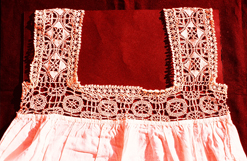Lefkara lace on:
[Wikipedia]
[Google]
[Amazon]
Lefkaritika or Lefkara Lace is a handmade lace from

 Lefkaritika is the characteristic type of
Lefkaritika is the characteristic type of
 The most characteristic pattern in Lefkara Lace is "potamoi" ("rivers"). They made from triangular zig-zags, called "kamares" ("arcs").
Contemporary lacemakers can reproduce Lefkara lace with guidance from books of historical information and patterns.
The most characteristic pattern in Lefkara Lace is "potamoi" ("rivers"). They made from triangular zig-zags, called "kamares" ("arcs").
Contemporary lacemakers can reproduce Lefkara lace with guidance from books of historical information and patterns.
Pano Lefkara
Pano Lefkara () is a village on the island of Cyprus famous for its lace, known as lefkaritika in (Greek: λευκαρίτικα) and silver handicrafts. The village takes its name from the white of its silica and limestone: Lefkara is derived fro ...
Cyprus. Notable characteristics are the hemstitch, satin stitch fillings, needlepoint edgings, white, brown, ecru colours and geometric intricate patterns. in 2009, this traditional craft of lace-making was inscribed on the Representative List of the Intangible Cultural Heritage
An intangible cultural heritage (ICH) is a practice, representation, expression, knowledge, or skill considered by UNESCO to be part of a place's cultural heritage. Buildings, historic places, monuments, and artifacts are cultural property. In ...
.
History

 Lefkaritika is the characteristic type of
Lefkaritika is the characteristic type of embroidery
Embroidery is the art of decorating Textile, fabric or other materials using a Sewing needle, needle to stitch Yarn, thread or yarn. It is one of the oldest forms of Textile arts, textile art, with origins dating back thousands of years across ...
art in Cyprus
Cyprus (), officially the Republic of Cyprus, is an island country in the eastern Mediterranean Sea. Situated in West Asia, its cultural identity and geopolitical orientation are overwhelmingly Southeast European. Cyprus is the List of isl ...
, dating back to at least the fourteenth century. It falls under the category of white embroidery
Embroidery is the art of decorating Textile, fabric or other materials using a Sewing needle, needle to stitch Yarn, thread or yarn. It is one of the oldest forms of Textile arts, textile art, with origins dating back thousands of years across ...
art of Cyprus. It is the evolution of an older type, called " asproploumia". The main stitches of "asproploumia" survived in the newest type of Lefkaritika. New stitches and motifs are added depending on the skill and creativity of the embroideress. Lefkaritika soon reached a higher level of quality, because of the competition between women, since they were considered to be a center piece of a dowry. Each girl had to have an extended collection ready for exhibition on her wedding day. This way a lot of the traditional elements were passed from mother to daughter. Many women practiced embroidery as a profession as well. Women embroideresses in Pano Lefkara
Pano Lefkara () is a village on the island of Cyprus famous for its lace, known as lefkaritika in (Greek: λευκαρίτικα) and silver handicrafts. The village takes its name from the white of its silica and limestone: Lefkara is derived fro ...
, called "ploumarisses" organised their production from home. Men from Lefkara, called "kentitarides", were merchants and they traveled across Europe and Scandinavia. According to tradition, in 15th century Leonardo da Vinci
Leonardo di ser Piero da Vinci (15 April 1452 - 2 May 1519) was an Italian polymath of the High Renaissance who was active as a painter, draughtsman, engineer, scientist, theorist, sculptor, and architect. While his fame initially rested o ...
visited Cyprus and took a Lefkara Lace back to Italy with him, which today decorates Duomo Cathedral in Milan.
Centers of production
The greatest centers of production used to bePano Lefkara
Pano Lefkara () is a village on the island of Cyprus famous for its lace, known as lefkaritika in (Greek: λευκαρίτικα) and silver handicrafts. The village takes its name from the white of its silica and limestone: Lefkara is derived fro ...
and Kato Lefkara
Kato Lefkara () is a village in the Larnaca District of Cyprus
Cyprus (), officially the Republic of Cyprus, is an island country in the eastern Mediterranean Sea. Situated in West Asia, its cultural identity and geopolitical orientatio ...
villages. Today these embroideries are manufactured all over Cyprus, especially in villages, Kato Drys, Vavla, Vavatsinia, Ora, Choirokoitia
Khirokitia (sometimes spelled Choirokoitia; , suggested meaning ''Pig-cradle'', from 'pig, boar' + 'place of origin, cradle') is an archaeological site on the island of Cyprus dating from the Neolithic age. It has been listed as a World Heri ...
, Skarinou, Dali and Athienou
Athienou ( or , ) is a village in Larnaca District, Cyprus. It is one of only four villages located within the United Nations Buffer Zone in Cyprus, United Nations Buffer Zone, the other three being: Pyla, Troulloi and Deneia. Today, Athienou ha ...
.
Materials and technique
The first Lefkara Lace was made from the local white cotton fabric produced in Cyprus. A combination of stitches and cuts is used. The large embroideries called "tagiades" are added to "dantela venis" ("Venice Lace"), "pittota", "gyroulota", "liminota" patterns. Their name comes from the Italian "'' Punto Tagliato''", a kind of a cut design popular in Italy during the 16th century, According to the Cyprus Handicraft Service the different motifs for Lefkara Lace add to more than 650. The most characteristic pattern in Lefkara Lace is "potamoi" ("rivers"). They made from triangular zig-zags, called "kamares" ("arcs").
Contemporary lacemakers can reproduce Lefkara lace with guidance from books of historical information and patterns.
The most characteristic pattern in Lefkara Lace is "potamoi" ("rivers"). They made from triangular zig-zags, called "kamares" ("arcs").
Contemporary lacemakers can reproduce Lefkara lace with guidance from books of historical information and patterns.
References
Bibliography
{{Lace_types Lace Textile arts of Cyprus Intangible Cultural Heritage of Humanity